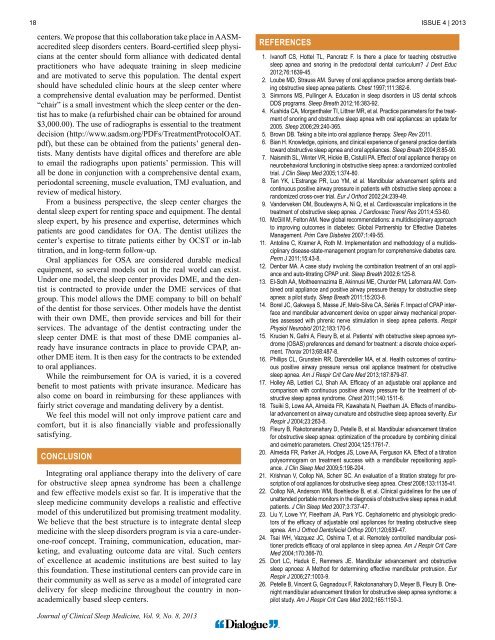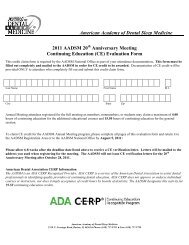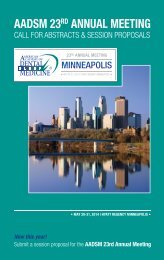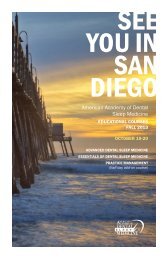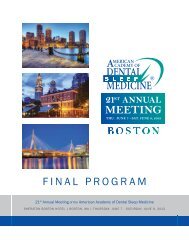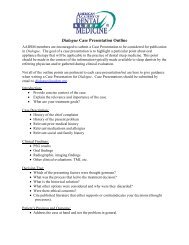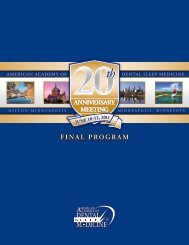In this issue - The American Academy of Dental Sleep Medicine
In this issue - The American Academy of Dental Sleep Medicine
In this issue - The American Academy of Dental Sleep Medicine
You also want an ePaper? Increase the reach of your titles
YUMPU automatically turns print PDFs into web optimized ePapers that Google loves.
18 S Sharma, G Essick, D Schwartz et al<br />
centers. We propose that <strong>this</strong> collaboration take place in AASMaccredited<br />
sleep disorders centers. Board-certified sleep physicians<br />
at the center should form alliance with dedicated dental<br />
practitioners who have adequate training in sleep medicine<br />
and are motivated to serve <strong>this</strong> population. <strong>The</strong> dental expert<br />
should have scheduled clinic hours at the sleep center where<br />
a comprehensive dental evaluation may be performed. Dentist<br />
“chair” is a small investment which the sleep center or the dentist<br />
has to make (a refurbished chair can be obtained for around<br />
$3,000.00). <strong>The</strong> use <strong>of</strong> radiographs is essential to the treatment<br />
decision (http://www.aadsm.org/PDFs/TreatmentProtocolOAT.<br />
pdf), but these can be obtained from the patients’ general dentists.<br />
Many dentists have digital <strong>of</strong>fices and therefore are able<br />
to email the radiographs upon patients’ permission. This will<br />
all be done in conjunction with a comprehensive dental exam,<br />
periodontal screening, muscle evaluation, TMJ evaluation, and<br />
review <strong>of</strong> medical history.<br />
From a business perspective, the sleep center charges the<br />
dental sleep expert for renting space and equipment. <strong>The</strong> dental<br />
sleep expert, by his presence and expertise, determines which<br />
patients are good candidates for OA. <strong>The</strong> dentist utilizes the<br />
center’s expertise to titrate patients either by OCST or in-lab<br />
titration, and in long-term follow-up.<br />
Oral appliances for OSA are considered durable medical<br />
equipment, so several models out in the real world can exist.<br />
Under one model, the sleep center provides DME, and the dentist<br />
is contracted to provide under the DME services <strong>of</strong> that<br />
group. This model allows the DME company to bill on behalf<br />
<strong>of</strong> the dentist for those services. Other models have the dentist<br />
with their own DME, then provide services and bill for their<br />
services. <strong>The</strong> advantage <strong>of</strong> the dentist contracting under the<br />
sleep center DME is that most <strong>of</strong> these DME companies already<br />
have insurance contracts in place to provide CPAP, another<br />
DME item. It is then easy for the contracts to be extended<br />
to oral appliances.<br />
While the reimbursement for OA is varied, it is a covered<br />
benefit to most patients with private insurance. Medicare has<br />
also come on board in reimbursing for these appliances with<br />
fairly strict coverage and mandating delivery by a dentist.<br />
We feel <strong>this</strong> model will not only improve patient care and<br />
comfort, but it is also financially viable and pr<strong>of</strong>essionally<br />
satisfying.<br />
CONClUSION<br />
<strong>In</strong>tegrating oral appliance therapy into the delivery <strong>of</strong> care<br />
for obstructive sleep apnea syndrome has been a challenge<br />
and few effective models exist so far. It is imperative that the<br />
sleep medicine community develops a realistic and effective<br />
model <strong>of</strong> <strong>this</strong> underutilized but promising treatment modality.<br />
We believe that the best structure is to integrate dental sleep<br />
medicine with the sleep disorders program is via a care-underone-ro<strong>of</strong><br />
concept. Training, communication, education, marketing,<br />
and evaluating outcome data are vital. Such centers<br />
<strong>of</strong> excellence at academic institutions are best suited to lay<br />
<strong>this</strong> foundation. <strong>The</strong>se institutional centers can provide care in<br />
their community as well as serve as a model <strong>of</strong> integrated care<br />
delivery for sleep medicine throughout the country in nonacademically<br />
based sleep centers.<br />
REFERENCES<br />
ISSUE 4 | 2013<br />
1. Ivan<strong>of</strong>f CS, Hottel TL, Pancratz F. Is there a place for teaching obstructive<br />
sleep apnea and snoring in the predoctoral dental curriculum? J Dent Educ<br />
2012;76:1639-45.<br />
2. Loube MD, Strauss AM. Survey <strong>of</strong> oral appliance practice among dentists treating<br />
obstructive sleep apnea patients. Chest 1997;111:382-6.<br />
3. Simmons MS, Pullinger A. Education in sleep disorders in US dental schools<br />
DDS programs. <strong>Sleep</strong> Breath 2012;16:383-92.<br />
4. Kushida CA, Morgenthaler TI, Littner MR, et al. Practice parameters for the treatment<br />
<strong>of</strong> snoring and obstructive sleep apnea with oral appliances: an update for<br />
2005. <strong>Sleep</strong> 2006;29:240-365.<br />
5. Brown DB. Taking a bite into oral appliance therapy. <strong>Sleep</strong> Rev 2011.<br />
6. Bian H. Knowledge, opinions, and clinical experience <strong>of</strong> general practice dentists<br />
toward obstructive sleep apnea and oral appliances. <strong>Sleep</strong> Breath 2004;8:85-90.<br />
7. Naismith SL, Winter VR, Hickie IB, Cistulli PA. Effect <strong>of</strong> oral appliance therapy on<br />
neurobehavioral functioning in obstructive sleep apnea: a randomized controlled<br />
trial. J Clin <strong>Sleep</strong> Med 2005;1:374-80.<br />
8. Tan YK, L’Estrange PR, Luo YM, et al. Mandibular advancement splints and<br />
continuous positive airway pressure in patients with obstructive sleep apnoea: a<br />
randomized cross-over trial. Eur J Orthod 2002;24:239-49.<br />
9. Vanderveken OM, Boudewyns A, Ni Q, et al. Cardiovascular implications in the<br />
treatment <strong>of</strong> obstructive sleep apnea. J Cardiovasc Transl Res 2011;4:53-60.<br />
10. McGill M, Felton AM. New global recommendations: a multidisciplinary approach<br />
to improving outcomes in diabetes: Global Partnership for Effective Diabetes<br />
Management. Prim Care Diabetes 2007;1:49-55.<br />
11. Antoline C, Kramer A, Roth M. Implementation and methodology <strong>of</strong> a multidisciplinary<br />
disease-state-management program for comprehensive diabetes care.<br />
Perm J 2011;15:43-8.<br />
12. Denbar MA. A case study involving the combination treatment <strong>of</strong> an oral appliance<br />
and auto-titrating CPAP unit. <strong>Sleep</strong> Breath 2002;6:125-8.<br />
13. El-Solh AA, Moitheennazima B, Akinnusi ME, Churder PM, Lafornara AM. Combined<br />
oral appliance and positive airway pressure therapy for obstructive sleep<br />
apnea: a pilot study. <strong>Sleep</strong> Breath 2011;15:203-8.<br />
14. Borel JC, Gakwaya S, Masse JF, Melo-Silva CA, Sériès F. Impact <strong>of</strong> CPAP interface<br />
and mandibular advancement device on upper airway mechanical properties<br />
assessed with phrenic nerve stimulation in sleep apnea patients. Respir<br />
Physiol Neurobiol 2012;183:170-6.<br />
15. Krucien N, Gafni A, Fleury B, et al. Patients’ with obstructive sleep apnoea syndrome<br />
(OSAS) preferences and demand for treatment: a discrete choice experiment.<br />
Thorax 2013;68:487-8.<br />
16. Phillips CL, Grunstein RR, Darendeliler MA, et al. Health outcomes <strong>of</strong> continuous<br />
positive airway pressure versus oral appliance treatment for obstructive<br />
sleep apnea. Am J Respir Crit Care Med 2013;187:879-87.<br />
17. Holley AB, Lettieri CJ, Shah AA. Efficacy <strong>of</strong> an adjustable oral appliance and<br />
comparison with continuous positive airway pressure for the treatment <strong>of</strong> obstructive<br />
sleep apnea syndrome. Chest 2011;140:1511-6.<br />
18. Tsuiki S, Lowe AA, Almeida FR, Kawahata N, Fleetham JA. Effects <strong>of</strong> mandibular<br />
advancement on airway curvature and obstructive sleep apnoea severity. Eur<br />
Respir J 2004;23:263-8.<br />
19. Fleury B, Rakotonanahary D, Petelle B, et al. Mandibular advancement titration<br />
for obstructive sleep apnea: optimization <strong>of</strong> the procedure by combining clinical<br />
and oximetric parameters. Chest 2004;125:1761-7.<br />
20. Almeida FR, Parker JA, Hodges JS, Lowe AA, Ferguson KA. Effect <strong>of</strong> a titration<br />
polysomnogram on treatment success with a mandibular repositioning appliance.<br />
J Clin <strong>Sleep</strong> Med 2009;5:198-204.<br />
21. Krishnan V, Collop NA, Scherr SC. An evaluation <strong>of</strong> a titration strategy for prescription<br />
<strong>of</strong> oral appliances for obstructive sleep apnea. Chest 2008;133:1135-41.<br />
22. Collop NA, Anderson WM, Boehlecke B, et al. Clinical guidelines for the use <strong>of</strong><br />
unattended portable monitors in the diagnosis <strong>of</strong> obstructive sleep apnea in adult<br />
patients. J Clin <strong>Sleep</strong> Med 2007;3:737-47.<br />
23. Liu Y, Lowe YY, Fleetham JA, Park YC. Cephalometric and physiologic predictors<br />
<strong>of</strong> the efficacy <strong>of</strong> adjustable oral appliances for treating obstructive sleep<br />
apnea. Am J Orthod Dent<strong>of</strong>acial Orthop 2001;120;639-47.<br />
24. Tsai WH, Vazquez JC, Oshima T, et al. Remotely controlled mandibular positioner<br />
predicts efficacy <strong>of</strong> oral appliance in sleep apnea. Am J Respir Crit Care<br />
Med 2004;170:366-70.<br />
25. Dort LC, Haduk E, Remmers JE. Mandibular advancement and obstructive<br />
sleep apnoea: A Method for determining effective mandibular protrusion. Eur<br />
Respir J 2006;27:1003-9.<br />
26. Petelle B, Vincent G, Gagnadoux F, Rakotonanahary D, Meyer B, Fleury B. Onenight<br />
mandibular advancement titration for obstructive sleep apnea syndrome: a<br />
pilot study. Am J Respir Crit Care Med 2002;165:1150-3.<br />
Journal <strong>of</strong> Clinical <strong>Sleep</strong> <strong>Medicine</strong>, Vol. 9, No. 8, 2013<br />
6


